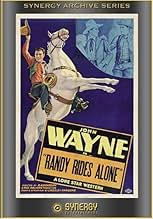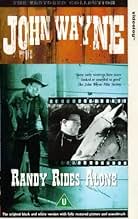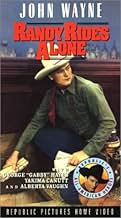AVALIAÇÃO DA IMDb
5,3/10
1,3 mil
SUA AVALIAÇÃO
Adicionar um enredo no seu idiomaJailed for murders he didn't commit, Randy escapes only to stumble into the den of the real murderers.Jailed for murders he didn't commit, Randy escapes only to stumble into the den of the real murderers.Jailed for murders he didn't commit, Randy escapes only to stumble into the den of the real murderers.
- Direção
- Roteirista
- Artistas
George 'Gabby' Hayes
- Marvin Black aka Matt the Mute
- (as George Hayes)
Artie Ortego
- Deputy Al
- (as Arthur Artego)
Horace B. Carpenter
- Ed Rogers
- (não creditado)
Tommy Coats
- Kidnapper Joe
- (não creditado)
Herman Hack
- Posse Rider
- (não creditado)
- …
Perry Murdock
- Kidnapper Slim
- (não creditado)
Tex Palmer
- Henchman
- (não creditado)
Mack V. Wright
- Deputy
- (não creditado)
Avaliações em destaque
I've never been a fan of westerns, which is probably why up until last night I'd never seen a film starring John Wayne. Of course it doesn't help that our lives only overlapped by a year, so I didn't have a great deal of opportunity to see any of his films (in the theater at least). I received this film in a VHS films lot that I won from ebay, so I finally popped it in last night and gave it a whirl.
I went in expecting a really low budget, really old western...needless to say, my expectations were pretty low. All in all, I'd have to say the film really isn't that bad. I don't have any other John Wayne films to compare it to, so thus far it's my favorite. I can however, compare it to other westerns, and frankly, it was no "Tombstone", but it was worth my time.
The story is nothing fantastic, but it's has it's moments. The acting was just fine as far as I could tell and overall production value was OK, granted it was made in the 30's, so again, I wasn't expecting much. One scene in particular made me laugh out loud. Whenever the halfway-house is shown from a bird's eye view it is CLEARLY a scale model, it's hilarious how bad it actually looks...but again...30's.
In any case, I have no idea who to recommend this film to, but I will say that it's really short (60 minutes) so it won't take up too much of your time and it's kind of fun to see a film this old to appreciate films of today and how far they've come, not to say that this is bad, but just to further appreciate film-making.
Hope you enjoy it.
P.S. I just realized that this film has the honor of being the 3rd oldest film I've ever seen (as of 7-26-2006).
I went in expecting a really low budget, really old western...needless to say, my expectations were pretty low. All in all, I'd have to say the film really isn't that bad. I don't have any other John Wayne films to compare it to, so thus far it's my favorite. I can however, compare it to other westerns, and frankly, it was no "Tombstone", but it was worth my time.
The story is nothing fantastic, but it's has it's moments. The acting was just fine as far as I could tell and overall production value was OK, granted it was made in the 30's, so again, I wasn't expecting much. One scene in particular made me laugh out loud. Whenever the halfway-house is shown from a bird's eye view it is CLEARLY a scale model, it's hilarious how bad it actually looks...but again...30's.
In any case, I have no idea who to recommend this film to, but I will say that it's really short (60 minutes) so it won't take up too much of your time and it's kind of fun to see a film this old to appreciate films of today and how far they've come, not to say that this is bad, but just to further appreciate film-making.
Hope you enjoy it.
P.S. I just realized that this film has the honor of being the 3rd oldest film I've ever seen (as of 7-26-2006).
Above average fare from the Lone Star crew of worthies-- Hayes, Canutt, Dwire, and of course Wayne. Lindsley Parsons did several scripts for Wayne and Lone Star, but this one's arguably his best. Wayne's an undercover agent on the trail of an outlaw gang whose latest robbery ends in a massacre of saloon patrons and staff. The opening is a grabber as the camera surveys the corpse strewn floor, while a player piano bangs away in the background, eyes peer from holes in a painting, and a secret panel opens. The outlaw gang has a neat hideout in a hollow behind a waterfall. Their digs even includes, of all things, its own jail where the leading lady ends up! Some good hard riding, including (alas!) a trip-wire spill that looks dramatic, but I wonder if the horse survived. Canutt comes up with usual spectacular stunt as Wayne takes a fall from a ladder high up a rock face. Can't help but notice that Alberta Vaughn looks much too young to stack up as an adult leading lady, but manages okay in the acting department. The movie's unusual for rare use of a miniature as a special effect. It's pretty well done and money well spent since the ending makes unexpectedly good use of it. All in all, it's good clean fun, as they used to say.
Another Wayne/Canutt/Hayes Lone Star entry, mostly enjoyable with the usual few tedious scenes thrown in. How any 52 minute movie can have tedious stretches is down to the love interest and various characters having to walk from one location to another. Riding is much more exciting after all!
It has a good start, with Wayne entering a saloon only to be greeted with a blood-bath, or was it just a good night previous? Chin-bald Hayes plays 2 characters, one the top baddie and the other a good-guy mute who has to write his words down on scraps of paper - more tedium. The key moment in RRA is after the heroine has said no to him as the good guy he starts to scribble an answer down to try to change her mind. Then he and the scriptwriter realise it won't do any good with only 5 minutes left so he petulantly blurts out "I'm fed up with this" and becomes his True Evil Self to her.
Some nice outdoor photography, nice print, nice scenes of the skinny Duke ambling around Alone before he's suddenly smitten with love. He improved his fight techniques in the coming years!
It has a good start, with Wayne entering a saloon only to be greeted with a blood-bath, or was it just a good night previous? Chin-bald Hayes plays 2 characters, one the top baddie and the other a good-guy mute who has to write his words down on scraps of paper - more tedium. The key moment in RRA is after the heroine has said no to him as the good guy he starts to scribble an answer down to try to change her mind. Then he and the scriptwriter realise it won't do any good with only 5 minutes left so he petulantly blurts out "I'm fed up with this" and becomes his True Evil Self to her.
Some nice outdoor photography, nice print, nice scenes of the skinny Duke ambling around Alone before he's suddenly smitten with love. He improved his fight techniques in the coming years!
"Randy Rides Alone" is one of the better entries in John Wayne's Lone Star westerns made in the early to mid 30s. And if you've ever wondered what George "Gabby" Hayes looked like without his whiskers, then this film is for you.
Wayne plays undercover investigator Randy Bowers who is sent to investigate a series of robberies committed by Marvin Black (Hayes) and his gang. He comes upon a half-way house which has apparently been robbed and everyone in it killed. But heroine Alberta Vaughn has escaped by hiding in a secret back room. Bowers meanwhile, is arrested for the carnage by the sheriff (Earl Dwire). Black masquerades as Marvin the Mute, the General Store owner, a respectable townsman. Bowers escapes jail and manages to infiltrate the gang and well, you probably can guess the rest.
John Wayne was in the midst of learning his craft in this series. This entry is better than most, particularly the "Singing Sandy" pictures. Hayes before he became "Gabby", played a variety of roles in the series. Sometimes he was the villain, other times the father of the heroine and sometimes a forerunner of the grizzled sidekick that we would soon come to know. Veteran stuntman Yakima Canutt also worked regularly in the series doubling just about everybody. He also played the parts of henchmen in several of them. In this one he's Hayes chief henchman "Spike".
Not a bad "B" western for its time.
Wayne plays undercover investigator Randy Bowers who is sent to investigate a series of robberies committed by Marvin Black (Hayes) and his gang. He comes upon a half-way house which has apparently been robbed and everyone in it killed. But heroine Alberta Vaughn has escaped by hiding in a secret back room. Bowers meanwhile, is arrested for the carnage by the sheriff (Earl Dwire). Black masquerades as Marvin the Mute, the General Store owner, a respectable townsman. Bowers escapes jail and manages to infiltrate the gang and well, you probably can guess the rest.
John Wayne was in the midst of learning his craft in this series. This entry is better than most, particularly the "Singing Sandy" pictures. Hayes before he became "Gabby", played a variety of roles in the series. Sometimes he was the villain, other times the father of the heroine and sometimes a forerunner of the grizzled sidekick that we would soon come to know. Veteran stuntman Yakima Canutt also worked regularly in the series doubling just about everybody. He also played the parts of henchmen in several of them. In this one he's Hayes chief henchman "Spike".
Not a bad "B" western for its time.
John Wayne made a slew of B Westerns for major and minor studios in the '30s before he hit it big with "Stagecoach" in 1939 for RKO. This was made for Monogram, a minor studio, and directed by Harry Fraser, a quirky director who spent his entire career grinding out B (and D, and Z . . . ) movies for long-forgotten studios like Resolute, Atlantic, PRC and Screen Guild. Working at a cheapo studio like Monogram would be considered the start of a downward slide for most directors; for Fraser it was a step up the career ladder, and he was ready for it. This could well be called one of, if the first, gothic Westerns; such things simply did not exist in 1934. It's eerie, atmospheric and has an especially shocking (for the time) opening scene. Randy (Wayne) rides into town after a long, dry trip and stops by the local saloon to wet his whistle. As he approaches it, he hears the tinkle of a piano coming from inside. Entering the establishment, however, he's greeted by a grisly sight: the piano is a player piano running by itself, and there are dead bodies lying everywhere. This film shows what can be done with almost no money but a lot of imagination and talent. This kind of movie wouldn't have been made at any of the big studios, but the independents could get away with a lot of things the majors couldn't (and wouldn't) do. This is an extremely offbeat, well done little film, not at all like Wayne's other westerns of the period. It's too bad Harry Fraser was never able to capitalize on the success of this movie (reportedly it made quite a bit of money and Wayne got along especially well with him); it would have been interesting to see what he would have been capable of with a bit more money and some major studio backing. Instead, he stayed pretty much where he was and ended his career making trash like "The White Gorilla" and "Chained for Life", about a murder committed by Siamese twins (!). Sorry, Harry.
Você sabia?
- CuriosidadesThough released in 1934 (5-6 years after the first talkies), the film is shot very much like a silent movie. Some scenes are silent except for the random sound effect. Dialog seems kept to a minimum, and sound quality of dialog is generally very poor (though this may be related to the quality of the specific print being shown by TCM). Camera moves are sometimes shaky and frame rate often makes movement jerky.
- Erros de gravaçãoThe Vollmer player piano shown in the saloon wasn't produced until the early twentieth century.
- Citações
Marvin Black, alias Matt Matthews: Well, where's the money?
Henchman Spike: We didn't get it. It wasn't in the safe.
Marvin Black, alias Matt Matthews: Whaddya mean, you didn't get it?
Henchman Spike: I'm telling you we couldn't find it.
Marvin Black, alias Matt Matthews: And you call yourselves "bad men"! I should have left you where I found you - brandin' calves!
- Versões alternativasIn 1985, Fox/Lorber Associates, Inc. and Classics Associates, Inc. copyrighted a version with new original music composed and orchestrated by William Barber. It was distributed for television by Fox/Lorber.
- ConexõesEdited into Meanwhile, Back at the Ranch (1976)
Principais escolhas
Faça login para avaliar e ver a lista de recomendações personalizadas
Detalhes
- Tempo de duração52 minutos
- Cor
- Proporção
- 1.37 : 1
Contribua para esta página
Sugerir uma alteração ou adicionar conteúdo ausente































